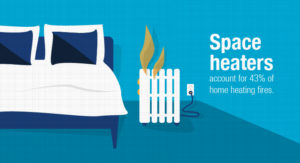How Small Space Heaters can be a Big Problem

During cold weather months, space heaters are a great way to take the chill out of the air. Even though they may be small in size, they’re capable of producing large amounts of heat, sparing you from having to dial up the thermostat.
Unfortunately, a newly released report from the National Fire Protection Association showed that space heaters are oftentimes responsible for residential fires, due to users underestimating their energy output.
Heating equipment is the second-leading cause of home fires in the U.S., according to recent estimates from the NFPA. More specifically, space heaters account for 43 percent of home heating fires and approximately 85 percent of fatalities are related to heating equipment.
Lorraine Carli, Vice President of outreach and advocacy at the NFPA, noted that space heaters are nice to have, but warned that they can be disasters waiting to happen when they’re misused.
“Space heaters can be effective tools for providing added warmth at home, but it’s critical that people follow basic precautions to ensure that they’re used safely,” Carli explained.
When do home heating fires typically occur?
For most of the U.S., December, January and February are the coldest months of the year. It’s this period in which residential fires caused by heating equipment typically occur, nearly 50 percent of which take place between 4 p.m. and midnight, according to the NFPA. The reason that they happen so often at this time is largely due to low evening temperatures and it being the window where many people are at home from work and school.
Carli said one of the most important aspects of responsible space heater use is placement. Ideally, they should be at a minimum three feet away from anything that can catch fire, such as furniture, curtains or linens.
Here are a few other tips to keep in mind before using a space heater of any sort:
Avoid maxing out temperature settings
Space heaters typically require a lot of energy from your electrical grid. Keeping the temperature setting on “high” can risk a surge and potentially blow a fuse. Instead, try to keep the temperature at a medium or low setting as much as possible.
Keep away from kids
If you have young children at home, make it clear to them that the space heater is not a toy and should be left alone. The NFPA recommends establishing a “kid-free zone” around any and all heating sources, electrical, wood stove or fireplace.
Turn off at night
You never know what can happen while you’re sound asleep so make sure to turn the unit off before heading to bed. You should also power it down if no one is in the room where it’s set up. Even if you’re leaving for a few minutes, err on the side of caution. You can always turn it back on when you return.
Accidents happen, and when they do, Blackmon Mooring & BMS CAT can make the repairs caused by fire, no matter how it started or the extent of the damage. Contact us to learn more about our residential fire and smoke damage restoration services.
